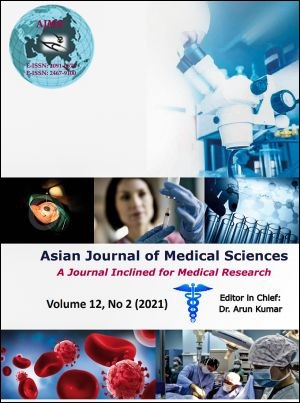The Pediatric Fluid Cytology: A 2-year experience of a tertiary care pediatric center of North India
DOI:
https://doi.org/10.3126/ajms.v12i1.30754Keywords:
Audit, Cytology, Fluid, PediatricsAbstract
Background: Body fluid analysis containing exfoliated cells in effusion may reveal information about neoplastic and non-neoplastic etiology. Most important indication of fluid cytology is to look for malignant cells. CSF examination is another investigation performed routinely in all tertiary care centers in addition to other body fluids examined.
Aims and Objective: The aim of the study was to examine the body fluids for cytological examination in diagnosis, prognostic and therapeutic tool for management of pediatric cases.
Materials and Methods: Retrospective data analysis of 170 fluid cytology cases taken from departmental data archive of pediatric cases (0-18 years) from Jan 2018-Dec 2019 was tabulated observation was done by 2independent pathologists. The smears were stained with Romanowsky stains and specialized stains of AFB and Rhodamine auramine, MPO, PAS and PAP as per requirement.
Results: There were higher number of male (n=99, 58.23%) compared to female (n=71, 41.76%). The commonest fluid cytology received was the CSF (n=150, 88.23%) with 77 samples presenting with significantly high TLC for age (using standard age analysis parameters). The diagnosis was grouped into the Neoplastic and Non neoplastic category. The non-neoplastic category was further divided into infective where most common was viral pleocytosis (n=50, 48 Viral lymphocytic pluecytosis, 1case rubella positive CSF, 1 Primary HLH with viral infection) followed by TB(n=10, 6 pleural, 2 CSF, 2 Peritoneal), bacterial (n=07, microbiology culture was done) and TORCH, Rubella with plasmacytosis (n=01). Another non-neoplastic category was of inherited disease where single case of Griscelli’s syndrome was diagnosed showing hemophagocytosis on CSF examination. Neoplastic Cytology was seen in 07 cases where all the cases were hematolymphoid malignancies.
Conclusion: This study concludes that fluid cytology is a useful diagnosis, prognostic, therapeutic tool in diagnosis and management of pediatric cases.
Downloads
177
305
Downloads
Published
How to Cite
Issue
Section
License
Authors who publish with this journal agree to the following terms:
- The journal holds copyright and publishes the work under a Creative Commons CC-BY-NC license that permits use, distribution and reprduction in any medium, provided the original work is properly cited and is not used for commercial purposes. The journal should be recognised as the original publisher of this work.
- Authors are able to enter into separate, additional contractual arrangements for the non-exclusive distribution of the journal's published version of the work (e.g., post it to an institutional repository or publish it in a book), with an acknowledgement of its initial publication in this journal.
- Authors are permitted and encouraged to post their work online (e.g., in institutional repositories or on their website) prior to and during the submission process, as it can lead to productive exchanges, as well as earlier and greater citation of published work (See The Effect of Open Access).




